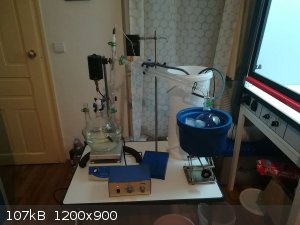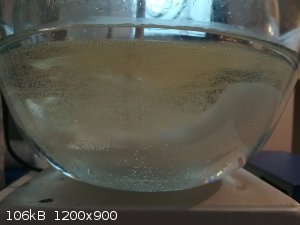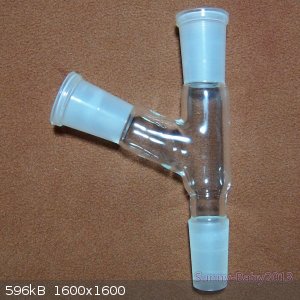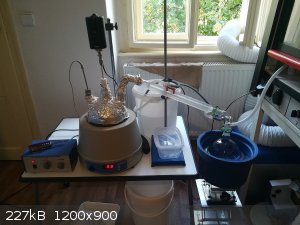| Pages:
1
2 |
nimgoldman
Hazard to Others
  
Posts: 303
Registered: 11-6-2018
Member Is Offline
|
|
Ethyl bromide synthesis not working
Okay today I attempted synthesis of ethyl bromide, a simple alkyl halide according to this writeup, section "Ethyl bromide". It is simply rewrite of Alfred E. Holt paper from 1916 (Journal of the Chemical Society):
| Quote: | In a 5 L flask, 300ml of water are added to 500ml (920g, 9.0 moles) of concentrated (96%) sulfuric acid. After cooling, 500ml (395g) of absolute
alcohol are run in (or 429g of 190 proof). Leave the flask in an ice bath to prevent the temperature from rising too much, When cold, slowly add 380g
of potassium bromide to the solution. Be sure to keep the solution cold to prevent the evolution of HBr gas.
Place the flask in a simple distillation set up and gently heat on a water bath at the lowest temperature that the ethyl bromide will distill over
(slowly i.e. 2-3 hrs; pure ethyl bromide distills at 38.4 C). The ethyl bromide is collected in cool water and washed by repeated shakings with water
then dried with calcium chloride ( it's dry when the calcium chloride no longer cakes up). |
Since I did this first time, I reduced all amounts by half. I also did't have potassium bromide but consulted that it can be replaced by sodium
bromide (slighly less is used by weight).
In a 2L RBF equipped with an overhead stirrer, I added 150 ml of cold water, then 250 ml 96% sulfuric acid, slowly and with stirring. The flask was
placed in an ice bath.
Then I added 214.5 g of 96% ethanol, dropwise. The temperature never exceeded 10 °C.
Finally, I slowly added 164.2 g of sodium bromide. About half of it dissolved but the rest remained on bottom as heavy salty island that remained even
after 30 minutes of strong stirring (stirring only caused a snowball effect but all the salt quickly settled again). NaBr simply refused to dissolve.
I added a fractionating column, condenser and a receiver flask. Magnetic stirring was not possible because of the heavy undissolved salt so I kept the
overhead stirrer in place (the stirrer stopper is sealed of course). I put the flask with reaction mixture in a hot water bath at 40 °C.
Unofurtunately, even after the reaction mixture reached the 38.5 °C, there is no boiling and no vapours generated.
The suspension got slighly yellow tint but now it's almost 45 °C and still no boiling occurs.
I don't know what could possibly went wrong since I followed the tutorial to the letter, even checked whether there is any ether evolved (none) or HBr
gas evolved (none) and the mixture contains the exact amounts as it should. So only ethyl bromide could have been generated but none is. I am
perplexed and lost.
Below are images of the apparatus and the reaction mixture. You can see the undissolved NaBr. The small bubbles are not from boiling, these are on the
outer container (the hot water bath).
 
[Edited on 12-9-2018 by nimgoldman]
|
|
|
S.C. Wack
bibliomaster
    
Posts: 2419
Registered: 7-5-2004
Location: Cornworld, Central USA
Member Is Offline
Mood: Enhanced
|
|
Disregard the heating quote...if the quantities are correct and qualities as you claim, your worries will reside in your condenser cooling. You don't
need or want a column...in other words blast away.
|
|
|
nimgoldman
Hazard to Others
  
Posts: 303
Registered: 11-6-2018
Member Is Offline
|
|
Quote: Originally posted by S.C. Wack  | | Disregard the heating quote...if the quantities are correct and qualities as you claim, your worries will reside in your condenser cooling. You don't
need or want a column...in other words blast away. |
According to PrepChem.com, the mixture can be left standing overnight, then distilled. Careful heating is not mentioned so I assume it can be heated
until it boils. Fractionate maybe later for purification.
Okay I stoppered the flask and tommorow I will simply distill it without a column, in a heating mantle and see.
[Edited on 12-9-2018 by nimgoldman]
|
|
|
S.C. Wack
bibliomaster
    
Posts: 2419
Registered: 7-5-2004
Location: Cornworld, Central USA
Member Is Offline
Mood: Enhanced
|
|
Let's hope there's no spontaneous reaction in the meantime.
Prepchem...tcboe...BTW admin Grandmaster P and some other members took it upon themselves to scan and host real lab manuals. They're still up
but...not on youtube.
[Edited on 12-9-2018 by S.C. Wack]
|
|
|
happyfooddance
National Hazard
   
Posts: 530
Registered: 9-11-2017
Location: Los Angeles, Ca.
Member Is Offline
Mood: No Mood
|
|
This is just a heating issue... There is no way you will get anything to distill over when you are only operating the bath 1.5° over the boiling
point of your compound, especially when your mixture has other higher boiling substances in it also. Think about it: could you ever distill water out
of an oil bath operating at 101.5°?And you especially couldn't distill water out of, say propylene glycol, at 101.5°. The boiling point of a mixture
is not often equal to the boiling point of the lowest boiling compound in a mixture.
I guess you are reading the wrong way into "distill at the lowest temperature at which the ethyl bromide distills over..." A big hint: if your ethyl
bromide isn't distilling over, it isn't hot enough.
I have done this only once, but it worked like a charm, I got just a bit below advertised yields, but that might have been because I was using acid
that was about 8% weaker than I had thought (only titrated it after the fact). I used KBr, at about half the scale you did (and I thought I was
foolhardy for trying a first time reaction on a mol scale...). I don't know exactly what I ran the bath at, but I know I had to raise it towards the
end and more ethyl bromide came over, and that I stopped it when the stillhead temp started rising sharply and reached about 50°.
|
|
|
nimgoldman
Hazard to Others
  
Posts: 303
Registered: 11-6-2018
Member Is Offline
|
|
Quote: Originally posted by happyfooddance  | | This is just a heating issue... There is no way you will get anything to distill over when you are only operating the bath 1.5° over the boiling
point of your compound, especially when your mixture has other higher boiling substances in it also. |
Yes that was my intuition. Sure mixtures always boil as mixtures. I heated up to 50 °C but no vapours appeared. At this point I stopped the
experiment.
I then found people usually get all of the ethyl bromide at 70 °C mark and won't raise temperature beyond that.
So it seems I was almost there. I will proceed with the distillation today with higher temp and see.
|
|
|
JJay
International Hazard
    
Posts: 3440
Registered: 15-10-2015
Member Is Offline
|
|
Quote: Originally posted by S.C. Wack  | | Disregard the heating quote...if the quantities are correct and qualities as you claim, your worries will reside in your condenser cooling. You don't
need or want a column...in other words blast away. |
I'd probably use this style receiver topped by a reflux condenser in case the product tries to escape, but it looks like you know what you're doing.

|
|
|
happyfooddance
National Hazard
   
Posts: 530
Registered: 9-11-2017
Location: Los Angeles, Ca.
Member Is Offline
Mood: No Mood
|
|
Quote: Originally posted by JJay  |
I'd probably use this style receiver topped by a reflux condenser in case the product tries to escape, but it looks like you know what you're doing.
|
That seems like a great way to unnecessarily increase the amount of product hold-up in the apparatus.
Just stick with the reciever in ice or ice/salt like you are doing.
|
|
|
JJay
International Hazard
    
Posts: 3440
Registered: 15-10-2015
Member Is Offline
|
|
Quote: Originally posted by happyfooddance  | Quote: Originally posted by JJay  |
I'd probably use this style receiver topped by a reflux condenser in case the product tries to escape, but it looks like you know what you're doing.
|
That seems like a great way to unnecessarily increase the amount of product hold-up in the apparatus.
Just stick with the reciever in ice or ice/salt like you are doing. |
LoL, that's one of the most ridiculous things ever posted on this board.
|
|
|
happyfooddance
National Hazard
   
Posts: 530
Registered: 9-11-2017
Location: Los Angeles, Ca.
Member Is Offline
Mood: No Mood
|
|
Quote: Originally posted by JJay  | Quote: Originally posted by happyfooddance  | Quote: Originally posted by JJay  |
I'd probably use this style receiver topped by a reflux condenser in case the product tries to escape, but it looks like you know what you're doing.
|
That seems like a great way to unnecessarily increase the amount of product hold-up in the apparatus.
Just stick with the reciever in ice or ice/salt like you are doing. |
LoL, that's one of the most ridiculous things ever posted on this board. |
Maybe you didn't see the one where you talk about using portland cement to dry ethanol.
|
|
|
JJay
International Hazard
    
Posts: 3440
Registered: 15-10-2015
Member Is Offline
|
|
Quote: Originally posted by happyfooddance  | Quote: Originally posted by JJay  | Quote: Originally posted by happyfooddance  | Quote: Originally posted by JJay  |
I'd probably use this style receiver topped by a reflux condenser in case the product tries to escape, but it looks like you know what you're doing.
|
That seems like a great way to unnecessarily increase the amount of product hold-up in the apparatus.
Just stick with the reciever in ice or ice/salt like you are doing. |
LoL, that's one of the most ridiculous things ever posted on this board. |
Maybe you didn't see the one where you talk about using portland cement to dry ethanol. |
This is not really the place for that discussion; please take it to the appropriate thread. Otherwise, your point is unclear; in particular, please
address exactly what you didn't like about my idea to dry ethanol with Portland cement, which is an indubitably viable method.
Getting back to the topic at hand, I can easily cite sources backing up the idea of topping the receiver with a reflux condenser. That shouldn't be
necessary, though; it should be abundantly obvious that there would be zero additional holdup. You're either unable to reach objective conclusions on
the subject or just trolling. I'd like to help.
|
|
|
Loptr
International Hazard
    
Posts: 1347
Registered: 20-5-2014
Location: USA
Member Is Offline
Mood: Grateful
|
|
Quote: Originally posted by JJay  | Quote: Originally posted by happyfooddance  | Quote: Originally posted by JJay  | Quote: Originally posted by happyfooddance  | Quote: Originally posted by JJay  |
I'd probably use this style receiver topped by a reflux condenser in case the product tries to escape, but it looks like you know what you're doing.
|
That seems like a great way to unnecessarily increase the amount of product hold-up in the apparatus.
Just stick with the reciever in ice or ice/salt like you are doing. |
LoL, that's one of the most ridiculous things ever posted on this board. |
Maybe you didn't see the one where you talk about using portland cement to dry ethanol. |
This is not really the place for that discussion; please take it to the appropriate thread. Otherwise, your point is unclear; in particular, please
address exactly what you didn't like about my idea to dry ethanol with Portland cement, which is an indubitably viable method.
Getting back to the topic at hand, I can easily cite sources backing up the idea of topping the receiver with a reflux condenser. That shouldn't be
necessary, though; it should be abundantly obvious that there would be zero additional holdup. You're either unable to reach objective conclusions on
the subject or just trolling. I'd like to help.
|
Guys, enough. You both made unnecessary comments.
Please get back on track. Thank you.
"Question everything generally thought to be obvious." - Dieter Rams
|
|
|
happyfooddance
National Hazard
   
Posts: 530
Registered: 9-11-2017
Location: Los Angeles, Ca.
Member Is Offline
Mood: No Mood
|
|
I'm waiting for the reference that says adding another condenser won't add hold-up.
|
|
|
nimgoldman
Hazard to Others
  
Posts: 303
Registered: 11-6-2018
Member Is Offline
|
|
I have modified the setup and now it finally works.
Actually nothing came over up to 76 °C but I observed white clouding and condensation on the wall.
The problem was therefore in the insulation. I wrapped the flask in alu foil and indeed short after first drops of bromoethane came over.
The reason why it worked for other without insulation is probably because they were using smaller flasks so there was less air and glass to reflux the
product.
Another concern for me was that stirrer stopper was leaking.
Next time I probably use HBr(aq.) instead of NaBr/KBr so that there is minium airspace, the flask can be sealed and the solution can be stirred
magnetically.

|
|
|
JJay
International Hazard
    
Posts: 3440
Registered: 15-10-2015
Member Is Offline
|
|
I have that same kind of stirrer and stir bearing. The stir paddles that ship with it don't fit neatly into those bearings; you can either use
different bearings or use paddles like these (in an appropriate size): https://www.ebay.com/itm/Lab-PTFE-Stirring-Paddle-Rod-Anchor...
Those paddles don't fit neatly into the chuck, so I stretch a piece of rubber cut from a rubber band over the end of the paddle (I remove a couple of
inches of PTFE first) and then snug the arbor down onto it, then tighten down the chuck. Works fine except over very long periods/high temperatures
that cause the rubber to degrade. They sell Jacobs chucks for that model stirrer, but they are expensive.
|
|
|
monolithic
Hazard to Others
  
Posts: 435
Registered: 5-3-2018
Member Is Offline
Mood: No Mood
|
|
Quote: Originally posted by JJay  | I have that same kind of stirrer and stir bearing. The stir paddles that ship with it don't fit neatly into those bearings; you can either use
different bearings or use paddles like these (in an appropriate size): https://www.ebay.com/itm/Lab-PTFE-Stirring-Paddle-Rod-Anchor...
Those paddles don't fit neatly into the chuck, so I stretch a piece of rubber cut from a rubber band over the end of the paddle (I remove a couple of
inches of PTFE first) and then snug the arbor down onto it, then tighten down the chuck. Works fine except over very long periods/high temperatures
that cause the rubber to degrade. They sell Jacobs chucks for that model stirrer, but they are expensive. |
Is it that the Chinese 100W stirrer that's sold all over eBay? Are you happy with ti?
|
|
|
JJay
International Hazard
    
Posts: 3440
Registered: 15-10-2015
Member Is Offline
|
|
That's a JJ-1 stirrer. I'm a fan.
|
|
|
nimgoldman
Hazard to Others
  
Posts: 303
Registered: 11-6-2018
Member Is Offline
|
|
The stirrer works fine even with the PTFE paddle. It sometimes fall off but that was fixed with a pliers.
Okay I ended up with approx. 1.34 mol of crude bromoethane (from 4.46 mol of ethanol). The yield based on ethanol is therefore less than 30% but I am
okay with it given it's the first try.
|
|
|
happyfooddance
National Hazard
   
Posts: 530
Registered: 9-11-2017
Location: Los Angeles, Ca.
Member Is Offline
Mood: No Mood
|
|
Quote: Originally posted by nimgoldman  | The stirrer works fine even with the PTFE paddle. It sometimes fall off but that was fixed with a pliers.
Okay I ended up with approx. 1.34 mol of crude bromoethane (from 4.46 mol of ethanol). The yield based on ethanol is therefore less than 30% but I am
okay with it given it's the first try. |
Ethanol is used in excess in this reaction, so you calculate yield based off of your limiting reagent, which in this case is sodium bromide. Unless
the price of ethanol is your biggest concern...
|
|
|
nimgoldman
Hazard to Others
  
Posts: 303
Registered: 11-6-2018
Member Is Offline
|
|
Quote: Originally posted by happyfooddance  | Quote: Originally posted by nimgoldman  | The stirrer works fine even with the PTFE paddle. It sometimes fall off but that was fixed with a pliers.
Okay I ended up with approx. 1.34 mol of crude bromoethane (from 4.46 mol of ethanol). The yield based on ethanol is therefore less than 30% but I am
okay with it given it's the first try. |
Ethanol is used in excess in this reaction, so you calculate yield based off of your limiting reagent, which in this case is sodium bromide. Unless
the price of ethanol is your biggest concern... |
I see. The yield is then 84.5% which sounds much better. It is actually lower as the product is not purified yet. This method can go over 94% if
conditions are optimal.
The bromide salt is the only expensive reagent here.
|
|
|
Dr.Bob
International Hazard
    
Posts: 2658
Registered: 26-1-2011
Location: USA - NC
Member Is Offline
Mood: No Mood
|
|
Using truly anhydrous ethanol will improve the yield as well. If you have 3-4 equivalents of ethanol, that will make it worse, if there is any
water in it. That is something I learned years ago, even a small amount of impurity can be bad if you use a large excess of a reagent. So
sometimes, less of the key reagent is better, even more if it is not extremely pure. For instance I found that in many cases using much more than 1
eq of an amine or acid in an amide coupling often caused any impurities to react faster than the desired compound, so 5 equivalents of an amine with a
20% impurity that is very reactive leads to very low yields of the desired product.
I would stir the thing for a day before distilling, that will allow the reaction to go leisurely, and go closer to completion. Sodium bromide is
also more hygroscopic, so it may hold some water as well, potassium salts tend to be drier in general.
|
|
|
nimgoldman
Hazard to Others
  
Posts: 303
Registered: 11-6-2018
Member Is Offline
|
|
I have tried the reaction but now with HBr(aq.) instead of NaBr. It works like a charm and it is much easier to set up as magnetic stirring is
possible.
I found that I need more cooling as just mixing the reagents already produces HBr and possibly BrEt gases.
Another improvement is using more efficient vertical condenser (probably Graham). Some product have been lost by escaping the apparatus.
I washed the product with conc. HCl, water, dilute NaHCO3, water. Then dried with CaCl2, filtered and re-distilled fractionally.
I found distillation was not necessary as the procedure already produced very pure ethyl bromide, distilling between 38.4-38.7 C.
[Edited on 4-10-2018 by nimgoldman]
|
|
|
Amos
International Hazard
    
Posts: 1406
Registered: 25-3-2014
Location: Yes
Member Is Offline
Mood: No
|
|
I obtained ethyl bromide in a 72% yield last week by following the method on prepchem, only working at 3x the scale and squeezing a bit more
efficiency out of my sulfuric acid by using only 90% of the amount recommended. The temperature rose as the distillation proceeded, and I collected
the distillate under a layer of saturated sodium chloride to prevent it evaporating away as quickly. I stopped when the droplets coming over didn't
increase the height of the lower layer, indicating mostly ethanol or water were distilling over. Sometimes it's best to trust your senses and
observations and not just the procedure you're following.
|
|
|
nimgoldman
Hazard to Others
  
Posts: 303
Registered: 11-6-2018
Member Is Offline
|
|
Quote: Originally posted by Amos  | | I obtained ethyl bromide in a 72% yield last week by following the method on prepchem, only working at 3x the scale and squeezing a bit more
efficiency out of my sulfuric acid by using only 90% of the amount recommended. The temperature rose as the distillation proceeded, and I collected
the distillate under a layer of saturated sodium chloride to prevent it evaporating away as quickly. I stopped when the droplets coming over didn't
increase the height of the lower layer, indicating mostly ethanol or water were distilling over. Sometimes it's best to trust your senses and
observations and not just the procedure you're following. |
Thanks for the tip of using saturated salt solution. I just used ice cold water to protect the bromoethane layer. I observed the droplets falling
through the water layer though it was harder to observe by the end of the distillation.
Yes the final procedure is almost always slightly different from what I followed initially.
Even NurdRage got significantly lower yield than reported in texts. It takes some tweaks, bells and whistles to get decent yield.
|
|
|
EliasExperiments
Hazard to Self
 
Posts: 57
Registered: 3-3-2020
Member Is Offline
|
|
I made a video on the process for anyone who is interested:
https://youtu.be/1pps8_M-xm0
My yield was 58 % even though I messed up badly, so the synthesis seems quite robust.
|
|
|
| Pages:
1
2 |